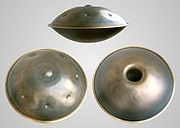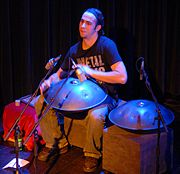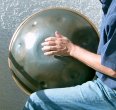
Hang (musical instrument)
Encyclopedia

Idiophone
An idiophone is any musical instrument which creates sound primarily by way of the instrument's vibrating, without the use of strings or membranes. It is the first of the four main divisions in the original Hornbostel-Sachs scheme of musical instrument classification...
created by PANArt in Switzerland
Switzerland
Switzerland name of one of the Swiss cantons. ; ; ; or ), in its full name the Swiss Confederation , is a federal republic consisting of 26 cantons, with Bern as the seat of the federal authorities. The country is situated in Western Europe,Or Central Europe depending on the definition....
. The Hang is made from two deep drawn
Deep drawing
Deep drawing is a sheet metal forming process in which a sheet metal blank is radially drawn into a forming die by the mechanical action of a punch. It is thus a shape transformation process with material retention. The process is considered "deep" drawing when the depth of the drawn part exceeds...
, nitrided steel sheets that are attached together creating the recognizable 'UFO shape'. There is nothing inside the Hang but air. The top ("Ding") side has a center 'note' hammered into it with seven or eight 'tone fields' hammered around it. The bottom ("Gu") is a simpler surface that has a rolled hole in the center with a tuned note that can be created when the rim is struck. The Hang uses some of the same physical principles as a steelpan
Steelpan
Steelpans is a musical instrument originating from The Republic of Trinidad and Tobago...
but with a nitrided surface and structural change of having two clamped shells with a small opening so that the instrument is a Helmholtz resonator. The creation of the Hang was the result of many years of research on the steelpan as well as the study of a diverse collection of instruments from around the world such as gong
Gong
A gong is an East and South East Asian musical percussion instrument that takes the form of a flat metal disc which is hit with a mallet....
s, gamelan
Gamelan
A gamelan is a musical ensemble from Indonesia, typically from the islands of Bali or Java, featuring a variety of instruments such as metallophones, xylophones, drums and gongs; bamboo flutes, bowed and plucked strings. Vocalists may also be included....
, ghatam
Ghatam
The ghaṭam is a percussion instrument used in the Carnatic music of South India. Its analogue in Rajasthan is known as the madga and pani mataqa "water jug"....
, drum
Drum
The drum is a member of the percussion group of musical instruments, which is technically classified as the membranophones. Drums consist of at least one membrane, called a drumhead or drum skin, that is stretched over a shell and struck, either directly with the player's hands, or with a...
s and bell
Bell (instrument)
A bell is a simple sound-making device. The bell is a percussion instrument and an idiophone. Its form is usually a hollow, cup-shaped object, which resonates upon being struck...
s. Metallurgical and acoustic research by the makers has led to significant changes and refinement in structure, design, and process over the years since the first Hang was offered.
The Hang is sometimes referred to as a hang drum. The 'drum' label, however, is discouraged by PANArt: "Treating it as a drum and promoting the name Hang Drum, for instance, has created a ripple effect of misinformation that leads to damaged Hang, physical injury, and mental and emotional turbulence."
Playing the Hang

Steelpan
Steelpans is a musical instrument originating from The Republic of Trinidad and Tobago...
.
The top ("Ding") side of the Hang, depending on how it is played, can sound like a harp, bells, or harmonically tuned steelpan
Steelpan
Steelpans is a musical instrument originating from The Republic of Trinidad and Tobago...
s. The notes are laid out in a cross pattern in the 'tone circle' from low to high so that with a specific orientation of the Hang, the player can ascend or descend the 'scale' by alternating using the left and right hands to strike the 'tone fields'. Each tone field has multiple overtones oriented specifically in the flattened field with a 'boss' or 'dimple' roughly at the center. Typically there is a fundamental tone, an overtone tuned to an octave
Octave
In music, an octave is the interval between one musical pitch and another with half or double its frequency. The octave relationship is a natural phenomenon that has been referred to as the "basic miracle of music", the use of which is "common in most musical systems"...
above that fundamental, and an additional overtone a fifth above that octave (twelfth/tritave). The orientation is fairly consistent across the fields on each Hang so that the overtones can be highlighted, muted, or extracted based on how and where the player strikes the tone field.
The 'bottom' (Gu side) of the Hang has ghatam
Ghatam
The ghaṭam is a percussion instrument used in the Carnatic music of South India. Its analogue in Rajasthan is known as the madga and pani mataqa "water jug"....
/udu
Udu
for other uses see Udu The udu is an African drum originated by the Igbo people of Nigeria. In the Igbo language, udu means vessel. Actually being a water jug with an additional hole, it was played by women for ceremonial uses. Usually the udu is made of clay...
-like properties using the Helmholtz resonance
Helmholtz resonance
Helmholtz resonance is the phenomenon of air resonance in a cavity, such as when one blows across the top of an empty bottle. The name comes from a device created in the 1850s by Hermann von Helmholtz, the "Helmholtz resonator", which he, the author of the classic study of acoustic science, used to...
that occurs within the clamped shallow shells. In the 2nd Generation and Integral Hang adjustment of the size of the opening of the Gu 'hole' (by partially blocking it with either a hand, or the legs) can generate a sympathetic D2 from the Helmholtz resonance that activates subtle layers of cross complexities in the resonance of the instrument as notes are played on the Ding side. In the 1st and 2nd Generation models there is a single high note with a long sustain that can be generated by striking the rim of the hole on the 'Gu' side. In the Integral Hang there are two notes that can be generated (F and F#). The Hang can also be used as a friction idiophone. Shaker like sounds can be made by sliding a hand across the surface, and it can also ring like a singing bowl
Singing bowl
Singing bowls are a type of bell, specifically classified as a standing bell. Rather than hanging inverted or attached to a handle, singing bowls sit with the bottom surface resting...
by using skin (a hand) or a bow.
Sound examples
 |
 |
Creation and development
The Hang was developed in 2000 in BerneBerne
The city of Bern or Berne is the Bundesstadt of Switzerland, and, with a population of , the fourth most populous city in Switzerland. The Bern agglomeration, which includes 43 municipalities, has a population of 349,000. The metropolitan area had a population of 660,000 in 2000...
, Switzerland
Switzerland
Switzerland name of one of the Swiss cantons. ; ; ; or ), in its full name the Swiss Confederation , is a federal republic consisting of 26 cantons, with Bern as the seat of the federal authorities. The country is situated in Western Europe,Or Central Europe depending on the definition....
by Felix Rohner and Sabina Schärer (PANArt Hangbau AG). It was introduced at the Musikmesse Frankfurt
Frankfurt Trade Fair
Frankfurt Trade Fair , with 448,000,000 Euros in sales and over 1,600 active employees, is one of the world's largest trade fair companies. The group has a global network of 28 subsidiaries, five branch offices, and 52 international sales partners. Thus, the Messe Frankfurt is present in over 150...
in 2001. Its name comes from the Bernese German
Bernese German
Bernese German is the dialect of High Alemannic German spoken in the Swiss plateau part of the canton of Bern and in some neighbouring regions.- Varieties :There is a lot of regional variation within Bernese German dialects...
word for hand. The two deep drawn steel hemispheres of the Hang are hardened by a process known as gas-nitriding
Nitridization
Nitriding is a heat treating process that diffuses nitrogen into the surface of a metal to create a case hardened surface. It is predominantly used on steel, but also titanium, aluminum and molybdenum....
. The side considered the 'bottom' has an opening (Gu) in the center which allows the generation of the bass note
Bass note
In music theory, the bass note of a chord or sonority is the lowest note played or notated. If there are multiple voices it is the note played or notated in the lowest voice. While the bass note is often the root or fundamental of the chord, it does not have to be, and sometimes one of the other...
through Helmholtz resonance. When it is played in a dampened way it can change in pitch similar to a talking drum. On the 'top' are seven (in the bass version of the Hang) or eight (treble version which is no longer produced) notes arranged in a 'Tone Circle' in zig-zag fashion from low to high. All are tuned harmonically (with fundamental
Fundamental frequency
The fundamental frequency, often referred to simply as the fundamental and abbreviated f0, is defined as the lowest frequency of a periodic waveform. In terms of a superposition of sinusoids The fundamental frequency, often referred to simply as the fundamental and abbreviated f0, is defined as the...
, octave
Octave
In music, an octave is the interval between one musical pitch and another with half or double its frequency. The octave relationship is a natural phenomenon that has been referred to as the "basic miracle of music", the use of which is "common in most musical systems"...
and the fifth
Perfect fifth
In classical music from Western culture, a fifth is a musical interval encompassing five staff positions , and the perfect fifth is a fifth spanning seven semitones, or in meantone, four diatonic semitones and three chromatic semitones...
above the octave) around a low note (Ding) at the center of the Tone Circle. Each creation is numbered and signed.

Aeolian mode
The Aeolian mode is a musical mode or, in modern usage, a diatonic scale called the natural minor scale.The word "Aeolian" in the music theory of ancient Greece was an alternative name for what Aristoxenus called the Low Lydian tonos , nine semitones...
, Ake Bono, Hijaz, Melog, Pygmy, and Zhi Diao. In 2005 PANArt was able to lower the tones on the Hang significantly in what they referred to as the Low Hang models with the Ding tuned to F3, E3 or Eb3. In the First Generation each creation was numbered, the model 'name' was written, and a signature of either Felix Rohner or Sabina Schärer was on a small note pasted on the inside of the top (Ding) surface.
In the spring of 2006 the Hang makers presented a new generation of Hang. The New Generation instruments (often referred to as 2nd generation) have a surface coating of annealed brass over the nitrided steel as well as a ring of brass around the circumference of the Hang. From the many different scales the Hang makers reduced to a structure with one type of central note (Ding) at D3. All New Generation models have two A notes (A3 and A4) as well as another D (D4) in the Tone Circle around the Ding. The remaining notes were mixed into several different configurations. Older Hanghang had tone fields with the oval indentation oriented radially towards the Ding, with the 2007 models (as well as the Integral Hang) the tone fields are angled at about 45° from a line drawn from the Ding to the edge. They also started marking the individual serial number on the inside of the Gu opening and signing each Hang at the outside edge of the Gu side of the Hang. No 'Sound Model' names were officially given to the 2nd Generation models.

In November of 2009 PANArt sent a letter to many who had requested a Hang indicating that there was a new development. The Free Integral Hang was to be the offering moving forward. This new approach appears to abandon 12 TET
Equal temperament
An equal temperament is a musical temperament, or a system of tuning, in which every pair of adjacent notes has an identical frequency ratio. As pitch is perceived roughly as the logarithm of frequency, this means that the perceived "distance" from every note to its nearest neighbor is the same for...
and A440
A440 (Concert A)
A440 is the musical note A above middle C. It has a frequency of 440 Hz and serves as a general tuning standard for musical pitch.Prior to the standardization on 440 Hz, many countries and organizations followed the Austrian government's 1885 recommendation of 435 Hz...
for an intuitive tuning approach that works with all the sound generating surfaces to integrate a more holistic creation.

